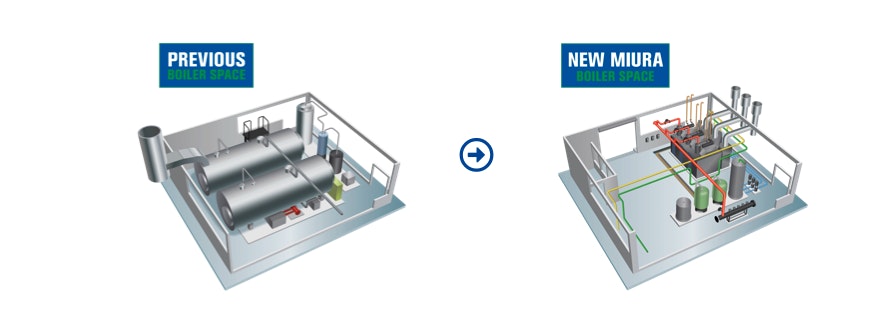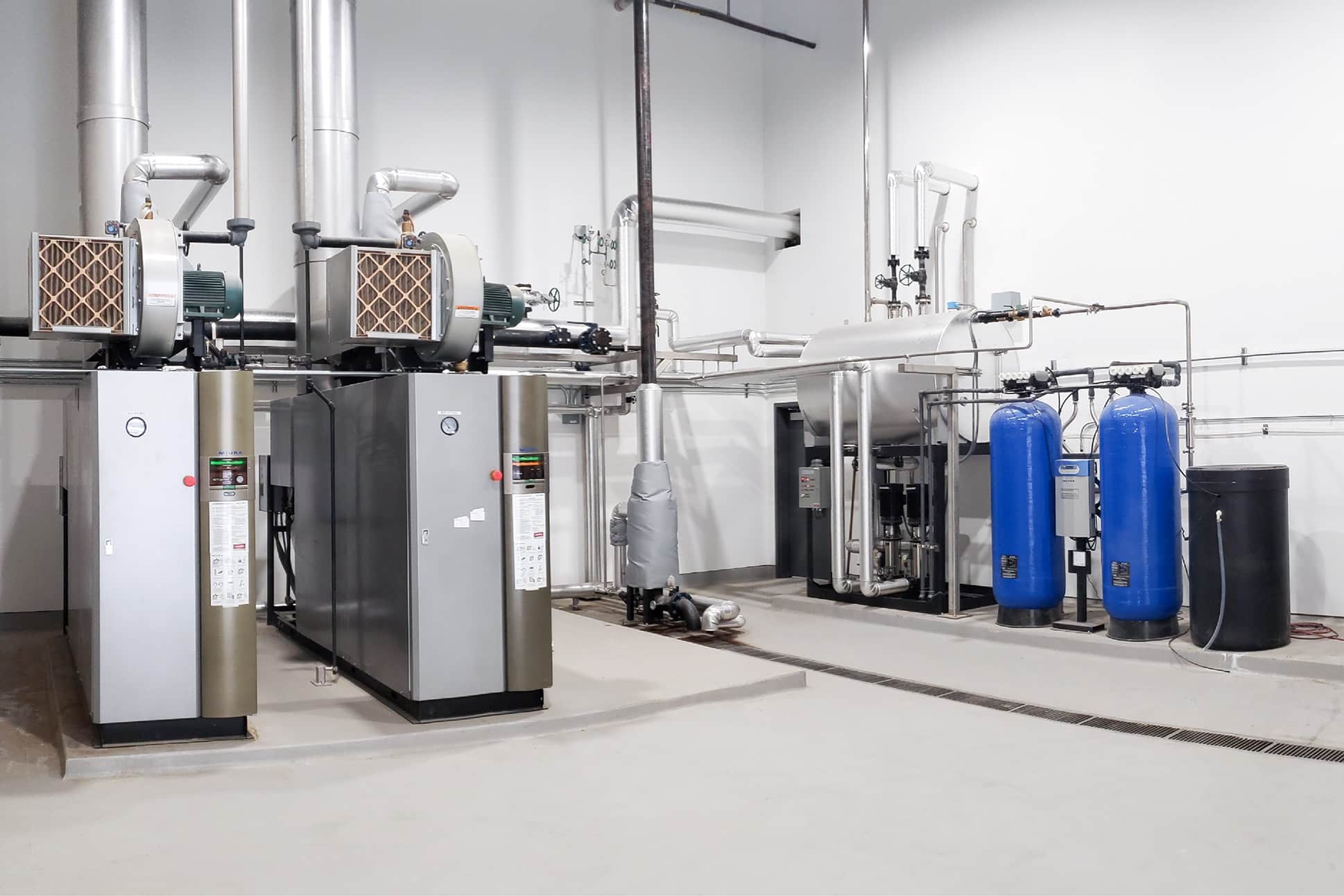How Pressure Simulations Help Chemical Processors Efficiently Balance Steam Load Demand
There’s no one-size-fits-all for boiler systems in a chemical processing plant. From differing steam load demands to factors such as the age of your plant and the space available, no two boiler room setups will ever look the same – even if you’re working with the same chemicals.
So, when it’s time to replace or upgrade your boiler system, you want something tailored to meet the individual steam needs of your facility.
Unfortunately, some boiler suppliers tend to oversell a particular setup, either providing more boilers than you need or ones too large to heat quickly, which creates an inefficient and more costly system to maintain over its lifespan.
At Miura, We Know That Efficiency is Your Top Priority When Dealing With Variable Steam Demands
We don’t recommend an oversold setup that doesn’t suit your exact requirements. Our detailed Pressure Simulations monitor the performance of your existing system, allowing our experts to work out precisely how to size a new boiler system to meet your steam plant needs appropriately.
Rick Gaston, a Miura expert, and Technical Support Manager, recently shared some in-depth insights with us on Miura’s Pressure Simulation process. Here’s what he had to say.
It’s a Numbers (and Not an Assumptions) Game
Chemical processing plants are intricately connected systems. Several crucial operating procedures are involved – from starting up and shutting down the plant to isolating machinery during maintenance or malfunctions. Steam production and transfer are integral in these processes, so getting it right is vital.
Simply assuming that a standard type of critical steam infrastructure can meet the needs of every chemical processing plant typically results in boiler suppliers overselling their clients, which wastes valuable boiler room space and impairs efficiency.
When asked about how Miura’s Pressure Simulations assist with correctly sizing a steam plant’s needs to meet requirements as efficiently and effectively as possible, Gaston shared the following:
“We understand that no two chemical processing plants use steam in the same way. When we use a Pressure Simulation to map out the requirements for your chemical plant, we need to rely on hard data and observation rather than simply assuming how the facility uses steam. We need to know how steam moves through a plant, for which particular processes it is needed, and the plant’s fluctuating load demand throughout the day.”
According to Gaston, even if plants work with the same chemicals, an individual boiler rooms’ relative age and layout can vary enormously – more factors to consider when sizing a chemical processing facility’s steam infrastructure requirements.
“For example, a plant that’s only been in operation for 20 years and needs new boilers can be relatively well laid-out and efficient, but some plants are 60 years old and trying to replace a boiler they purchased in 1965. If they have rearranged the boiler room two or three times (to help scale production, for example), we need to factor this into any recommendations we make for replacing and installing their boiler room equipment.”
How We Size Your Steam Boiler Infrastructure Correctly
To tailor a new boiler system to meet your exact needs, Miura combines data from each steam boiler in your system with insights into how you use your existing boiler room equipment. This load profile provides an overarching picture of your plant’s steam demands at different times.
“We want to understand your maximum steam demand, your minimum steam demand, and how the load fluctuates between the two. If you have one boiler, two, or more, we need to know the approximate steam output for those boilers. By understanding your average steam demand and how that changes, we know how many Miura boilers to recommend and install,” explained Gaston.
This data is provided to Miura directly from a facility’s system records. If data is sensitive, Miura’s technicians can install sensors on each boiler to gather information.
“Usually, we collect data for at least two weeks,” Gaston explained. “If your plant has seasonal demands, we try to record data in your high and low seasons.”
Gaston observed that, in most instances, a chemical plant wouldn’t need steam 24/7.
“Instead, a chemical processing facility usually needs different steam loads at different times of the day. This also depends on the exact machinery used because most appliances need to warm up first. If a facility has equipment that needs to be brought up to temperature in the morning when the whole plant comes online, we’ll probably see a huge spike in maximum load demand. Once the equipment has warmed up, that demand may drop by half or even back down to idle throughout the day.”
In addition to the number of boilers in a boiler room system, a facilities load demand, and each boiler’s steam output, we also consider how many standby boilers a plant needs to be kept in low-fire for bringing online quickly if and when required.
Building in Efficiencies with Modular Configurations
According to Gaston, a crucial aspect of correctly sizing a plant’s steam boiler infrastructure is working out how to build in additional efficiencies.
“In chemical processing, you don’t necessarily want your equipment to peak simultaneously because you may need to stagger your steam generation,” he explained.
Fortunately, the in-built efficiencies of Miura’s modular watertube boilers perfectly meet the demands of the chemical processing industry. For instance, a Miura steam boiler system involves multiple boilers with significantly smaller footprints than traditional firetube machinery, making the boiler room smaller, and freeing up space for other necessary infrastructure.
Multiple Miura steam boiler units work together to share the steam load and keep up with changing demand within seconds.


Another benefit is that Miura’s modular boiler units have rapid start-up times – they can produce steam from a cold start in five minutes or less. This means that, during periods of low steam demand, one or two boilers can hold down the fort in low fire mode.
When demand is higher, extra boilers can fire up to meet the increased workload in seconds. Operators can run just a portion of their system to match reduced steam demand until the load demand increases, saving money and boosting efficiencies.
Gaston provided the following example of how a Miura boiler system can be sized to accommodate a chemical processing facility’s fluctuating load demands:
“Miura’s Pressure Simulation records the maximum steam output needed by a chemical processing plant. Let’s say that your system requires 100,000 lbs per hour of steam when facing maximum demands. Miura LX-300 boilers produce approximately 10,000 lbs of steam per hour, so we might recommend ten LX-300 boilers as one solution. Or we could recommend a larger number of smaller boilers, such as twenty LX-150 units (which produce 5,000 lbs of steam). This decision depends on your minimum loads, size of your boiler room, and how the system needs to be built.”
Miura’s modular LX-Series steam boilers range in size and steam output to be able to meet a range of steam plant load profiles and sizes.

According to Gaston, the pressure band a steam plant requires can also dictate the type of boilers that Miura suggests.
“If you’re trying to hold a narrow pressure band, you may need smaller boilers for finer control over that demand; In these cases, four LX-150s or even six LX-100s might be better. Ultimately, we’re trying to suggest boiler sizes that match the profile of your steam plant and still fit within your existing boiler room space.”
A Real-World Steam Room Sizing Example
In 2009, FUJIFILM Hunt Chemicals decided to reevaluate the energy efficiency of their plant’s boiler room, concluding that their outdated steam plant – and old locomotive-style boilers – needed an upgrade.
As a chemical processing plant, FUJIFILM’s steam demand is variable due to its cyclical batch processes, requiring the plant’s reactors to be heated up and cooled down, leading to inefficiencies. According to Manuel Calero, Maintenance Manager at FUJIFILM, the two existing boilers weren’t well suited to the task: “They just sat there making steam that wasn’t being used.”
FUJIFILM chose to install two Miura EX-200 SGO dual-fuel boilers, with significant results.
“We once had two boilers with a full combined output of 400-horsepower,” said Calero, “We now have one on-demand 200 horsepower Miura boiler basically running the facility on low fire, with the second unit… on standby.”
He added that the Miura EX-200 boilers manage FUJIFILM’s load demand peaks and valleys “very well.”
“When a reactor comes online to be heated, the Miura boiler provides the steam required, and maybe 10 to 15 minutes later, it goes to low fire and drops off. Our facility runs 24/7, and now we’ll never have to shut down because of steam issues.”
The compact nature of Miura’s boiler design further enabled FUJIFILM to install the new boilers in an existing building instead of spending $70,000 on a new facility, making the project more affordable.
Click here for more information about the benefits of Miura’s modular, low NOx steam boilers.
Alternatively, contact a Miura representative today to explore how correctly sizing your steam boiler system can help build long-term efficiencies for your chemical processing plant.

